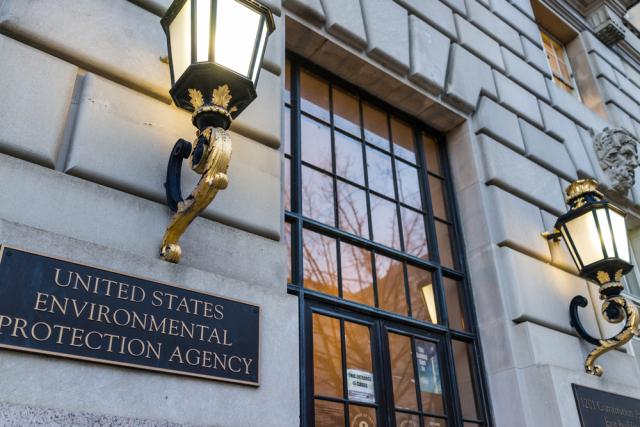
The Texas Railroad Commission knows the state’s terrain better than the federal government and is better suited to handling CO2 injection permits, says Hunton Andrews Kurth's Fred Eames and Ian Goldberg. (Source: Shutterstock)
The views expressed herein are those of the authors and not of Hunton Andrews Kurth or its clients. Hunton Andrews Kurth’s Sam Brown, Shannon Broome, Jason Hill and Mike O’Leary contributed to this article.
We strongly encourage the U.S. Environmental Protection Agency (EPA) to approve the Texas Railroad Commission’s application for primacy enforcement to oversee underground injections of CO2.
Recently two members of Texas’ congressional delegation wrote to the EPA opposing the state’s application to run what is known as Class VI of the Underground Injection Control program, contending that the state will not protect the public. That program regulates much, though not all, underground storage of CO2.

Contrary to the assertion of the two members of Texas’ congressional delegation, we strongly believe Texas should be authorized to run the Class VI program. We are practitioners in law related to carbon capture and sequestration, or CCS, which generally involves capturing CO2 from industrial sources and piping it a mile or more underground to keep it from being emitted into the atmosphere.
CCS is a critical technology for lowering emissions from energy use. It is widely acknowledged by groups such as the International Energy Agency and the U.S. government that emission reduction targets will not be met without CCS.
We are going to be using fossil fuels for decades to come, even as we increase use of lower-emission forms of energy, such as wind and solar, geothermal, nuclear and hydrogen. Thirty years from now the U.N. predicts we will have an additional 3 billion people on the planet living in cities—the equivalent of another 350 New York Cities.
We will need a mix of energy sources, including fossil fuels, and with new technologies these too will generate less carbon than the mix of sources of energy that have been used in past decades.The Class VI regulations, which Texas has applied to administer, are important to achieving the goal of lowering the carbon intensity of the energy mix that the country will have over the coming decades in a manner protective of public health and the environment. They require project developers to undergo an extensive up-front process to understand the subsurface—to make sure a geological formation has the ability to store and permanently contain CO2. We have helped clients with permit applications and know the regulations are robust.
The Railroad Commission has a thorough understanding of its subsurface, perhaps more than any other state, after regulating oil and gas production for more than a century. It has much more experience with its geologic formations than the EPA, which would continue to run the program if the Railroad Commission’s application is not approved.
For example, the Railroad Commission has regulated for many years underground injections under the similar Class II program, which regulates injections related to oil and gas production. Many times, those injections include CO2, just as injections would under the Class VI program.
The EPA simply lacks the resources to handle this task. Even though Congress awarded the EPA extra funding in the Bipartisan Infrastructure Law two years ago to speed up Class VI permitting, the backlog of permit applications pending with the EPA has grown from about a dozen in 2021 to about 90 today. See Hunton Andrews Kurth’s Class VI Program Permit Tracker here.
The states (including Texas) collectively can dedicate more resources to the job of evaluating Class VI permit applications. And this is how Congress intended the program to work. It wanted states, which are on the front lines and most familiar with their environmental and geologic issues to be responsible for permitting (with federal oversight). Texas should not be deprived of the rights that are intended for all states, especially when its program meets the regulatory requirement to administer the program.
We note that two other members of Texas’ congressional delegation introduced legislation earlier this year, passed by the House of Representatives, to speed up EPA approvals of state applications to run the Class VI program.

Two other States—North Dakota and Wyoming—already have been approved to administer the Class VI program within their borders. Louisiana applied in 2020, and its application is undergoing review and has been proposed for approval. Several other states reportedly are undertaking steps necessary to apply.
Energy projects around the country, which are important to meeting the energy needs of the U.S. population, will be able to move faster, and CO2 that would otherwise have entered the atmosphere could be sequestered on a much more rapid time frame than if Texas is denied approval. EPA must move faster in approving competent states, including Texas, to run Class VI regulatory programs. That will enable the country to maintain reliable energy while further reducing CO2 emissions.
Recommended Reading
NOG Closes Utica Shale, Delaware Basin Acquisitions
2024-02-05 - Northern Oil and Gas’ Utica deal marks the entry of the non-op E&P in the shale play while it’s Delaware Basin acquisition extends its footprint in the Permian.
Vital Energy Again Ups Interest in Acquired Permian Assets
2024-02-06 - Vital Energy added even more working interests in Permian Basin assets acquired from Henry Energy LP last year at a purchase price discounted versus recent deals, an analyst said.
California Resources Corp., Aera Energy to Combine in $2.1B Merger
2024-02-07 - The announced combination between California Resources and Aera Energy comes one year after Exxon and Shell closed the sale of Aera to a German asset manager for $4 billion.
DXP Enterprises Buys Water Service Company Kappe Associates
2024-02-06 - DXP Enterprise’s purchase of Kappe, a water and wastewater company, adds scale to DXP’s national water management profile.
Tellurian Exploring Sale of Upstream Haynesville Shale Assets
2024-02-06 - Tellurian, which in November raised doubts about its ability to continue as a going concern, said cash from a divestiture would be used to pay off debt and finance the company’s Driftwood LNG project.





